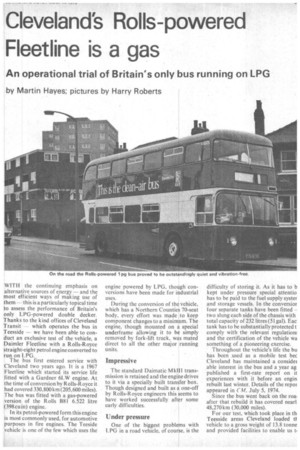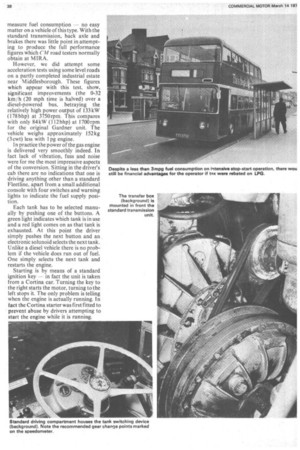Cleveland's Rolls-powered Fleetline is a gas
Page 39

Page 40

Page 41

Page 42

If you've noticed an error in this article please click here to report it so we can fix it.
An operational trial of Britain's only bus running on LPG
by Martin Hayes; pictures by Harry Roberts
WITH the continuing emphasis on alternative sources of energy — and the most efficient ways of making use of them — this is a particularly topical time to assess the performance of Britain's only LPG-powered double decker. Thanks to the kind offices of Cleveland Transit which operates the bus in Teesside — we have been able to conduct an exclusive test of the vehicle, a Daimler Fleetline with a Rolls-Royce straight-eight petrol engine converted to run on 1.PG.
The bus first entered service with Cleveland two years ago. It is a 1967 Fleetline which started its service life fitted with a Gardner 6LW engine. At the time of conversion by Rolls-Royce it had covered 330,800 km (205,600 miles). The bus was fitted with a gas-powered version of the Rolls B81 6.522 litre (398 cu in) engine.
In its petrol-powered form this engine is most commonly used, for automotive purposes in fire engines. The Teeside vehicle is one of the few which uses the engine powered by LPG, though conversions have been made for industrial uses.
During the conversion of the vehicle, which has a Northern Counties 70-seat body, every effort was made to keep component changes to a minimum. The engine, though inounted on a special underframe allowing it to be simply removed by fork-lift truck, was mated direct to all the other major running units.
Impressive
The standard Daimatic M k111 transmission is retained and the engine drives to it via a specially built transfer box. Though designed and built as a one-off by Rolls-Royce engineers this seems to have worked successfully after some early difficulties.
Under pressure
One of the biggest problems with I .PG in a road vehicle, of course, is the
difficulty of storing it. As it has to b kept under pressure special attentio has to be paid to the fuel supply syster and storage vessels. In the conversior four separate tanks have been fitted two slung each side of the chassis with total capacity of 232 litres (51gal). Eac tank has to be substantially protected t comply with the relevant regulation: and the certification of the vehicle wa something of a pioneering exercise.
Throughout the vehicle's life the bu has been used as a mobile test bee Cleveland has maintained a consider able interest in the bus and a year ag published a first-rate report on it experiences with it before an engin rebuilt last winter. Details of the repor appeared in CM. July 5, 1974.
Since the bus went back on the row after that rebuild it has covered nearl 48,270 km (30,000 miles).
For our test, which took place in th Teesside areas Cleveland loaded tf vehicle to a gross weight of 13.8 tonne and provided facilities to enable us ti
measure fuel consumption — no easy matter on a vehicle of this type. With the standard transmission, back axle and brakes there was little point in attempting to produce the full performance figures which CM road testers normally obtain at MIRA.
However, we did attempt some acceleration tests using some level roads on a partly completed industrial estate near Middlesborough. These figures which appear with this test, show, significant improvements (the 0-32 km/h (20 mph time is halved) over a diesel-powered bus, betraying the relatively high power output of 133 kW (178 bhp) at 3750rpm. This compares with only 84kW (112bhp) at 1700rpm for the original Gardner unit. The vehicle weighs approximately 152kg (3 cwt) less with 1 pg engine.
In practice the power of the gas engine is delivered very smoothly indeed. In fact lack of vibration, fuss and noise were for me the most impressive aspects of the conversion. Sitting in the driver's cab there are no indications that one is driving anything other than a standard Fleetline, apart from a small additional console with four switches and warning lights to indicate the fuel supply position.
Each tank has to be selected manually by pushing one of the buttons. A green light indicates which tank is in use and a red light comes on as that tank is exhausted. At this point the driver simply pushes the next button and an electronic solunoid selects the next tank. Unlike a diesel vehicle there is no problem if the vehicle does run out of fuel. One simply selects the next tank and restarts the engine.
Starting is by means of a standard ignition key in fact the unit is taken from a Cortina car. Turning the key to the right starts the motor, turning to the left stops it. The only problem is telling when the engine is actually running. In fact the Cortina starter was first fitted to prevent abuse by drivers attempting to start the engine while it is running. When I first boarded the vehicle I sumed the engine was switched off. anding at the front for some minutes tile preparations were made I really d no idea that the engine was in fact iing all the time. From the driver's seat is can at times present a very real Iiculty. The transmission is probably a Achilles heel of the conversion and th the considerable disparity in revs over 2000 more at maximum for the s engine as opposed to the diesel — d at times getting smooth changes is t easy. Most drivers, myself included, tend to change gear by using the engine note as a guide. Most of the time this is just not possible in this vehicle and, although recommended change points are marked on the speedometer, I found it quite difficult to adjust to the different techniques needed. The marked changeup points are at 6,225 and 35 km/ h (5.14 and 22 mph). In fact it is quite possible to obtain satisfactory changes once one has understood that this engine gains and looses revs far more quickly than normal diesels. By the end of a full day at the wheel I felt I had perfected the technique and there was no more difficulty. Only when I drove a diesel bus of similar vintage did I realize have different the technique was.
So smooth
At least as misleading for those unfamiliar with the bus as the lack of noise is the complete lack of vibration. Sitting on the rearmost seat in the lower saloon it is possible to detect some faint rumble from the engine but, elsewhere this is impossible for most of the time. When idling at rest, for example, the mirrors normally a tell-tale sign of any vibration — remain completely motionless. Engaging drive from neutral has no noticeable effect either, with none of the -elonk" that often accompanies that operation.
Intensive
To enable us to obtain realistic fuel consumption figure we took the loaded bus around two intensively used bus routes in Teeside, making ten second stops at all the recognized bus stops. This sort of exercise particularly if the route is a unknown one — is an excellent test for any vehicle because the driver's concentration is directed almost entirely to traffic situations route finding and so on. In these circumstances the R oils-powered Fleetli rie showed up very well, with no undue vices.
Although component failures with the bus have been very few indeed the carburetter had been changed. It was this change which was blamed for the rather disappointing consumption figures which we obtained. On our test routes we averaged less than 1.06km/1 (3 mpg). In practice, since the engine rebuild 12 months ago, the bus had been returning an average of about 1.24 km/ I (3.4(3.5 mpg) though the most recent figures show a considerable decline, indicating that our test figures are fairly accurate and that something must be amiss.
On similar duties, identical vehicles in the same fleet fitted with Gardner engines are returning about 2.62km/1 (7.4 mpg). It can be seen, therefore, that there is a substantial difference in consumption though LPG is considerably cheaper.
A more detailed analysis of the fuel cost situation, which if LPG were fully rebated would result in a net gain for the operator despite the higher consumption, is included elsewhere in this issue. However, that under present tax arrangements Cleveland is suffering a considerable financial disadvantage.
Rebuilt engine
Immediately after our test run the bus blotted its copy-book by breaking an oil pipe and suffering an engine seizure. As yet no identifiable cause has been discovered for this failure but the bus will shortly be back on the road with a rebuilt engine and will continue to operate in Cleveland's fleet. It is only fair to say that in the previous 12 months the only parts needed have been two starter motors, three rotor arms, two sets of points, one coolant pump, one Joint and two belts.
From our test of the vehicle it is clear that the claims of both Operator and engine manufacturer in terms of Unproved accelleration, reduced noise, reduced vibration and improved heating are easily borne out. It is doubtful, however, whether these are sufficient to repay the present financial disadvantage, though any change in the tax situation could significantly alter this.
Future conversions using this power pack will undoubtedly require further attention to finding a suitable transmission — and I gather that an Allison
unit is being considered but otherwise there seem few technical problems to be overcome. Now it is up to the Government to decide if it wants to encourage use of this pollution free fuel in Britain's city centres.








































































































